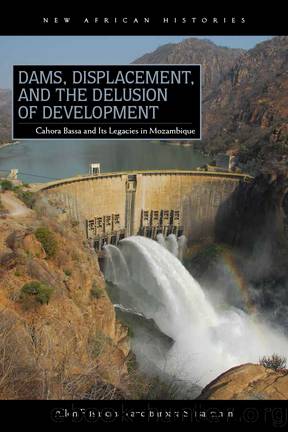Dams, Displacement, and the Delusion of Development by Isaacman Allen F.;Isaacman Barbara S.;

Author:Isaacman, Allen F.;Isaacman, Barbara S.;
Language: eng
Format: epub
Publisher: Ohio University Press
Published: 2013-03-22T00:00:00+00:00
A fourth, more significant, factor was the speed with which fishermenâdesperate to maximize their catches in the face of fierce competitionâadopted higher yielding, but unsustainable, harvesting methods.946They did so by replacing the coarse, locally produced fiber nets used in the past with imported finer-mesh, machine-made gill nets whose openings were less than half as wide.947Aniva João described why the new âmosquitoâ nets quickly became so popular: âThe mosquito netâs openings were very fine. Two fishermen entered the water, each holding one end of the net. When they placed the net below the surface, it was like putting on a capulana [a cloth worn by African men and women]. It covered everything. Nothing could escape. In a few hours they could fill several sacks.â948Fishermen began to use this finer material for their larger kokota nets, which enabled them both to enclose an area of several hundred meters and to ensnarl very young fish,949thus depleting future populations. While such innovations enabled fishermen to increase their daily haul and their profits, they violated a long-standing cultural prohibition against overfishing. As Marita Zhuwao explained, âIn the past, if one continued to fish even after one caught sufficient fish for oneâs family, the spirits [of the river] would get angry. Then, if one threw in the nets to catch more fish, maybe one would catch a dead baby, or some other bad omen.â950The spirits were right. Capturing many more younger and smaller fish had a devastating effect on the reproductive capacity of numerous of species in the lower Zambezi.951Many areas quickly showed signs of being overfished, and yields fell even further.
While no catch statistics exist for the region as a whole, available evidence points conclusively to a radical decline in freshwater fisheries after 1975. Before the Zambeziâs impoundment, the annual total catch in the delta was calculated at between thirty and fifty thousand tonnes per year; less than a decade after the damâs completion it had dropped by 25 to 50 percent.952The number of fishing camps and drying racks also plummeted.953In Marromeu, which had been a commercial fishing center, less than 20 percent of the households were engaged in this activity in 2000,954and many delta fisheries were abandoned, except during years of exceptional flooding.955Moreover, the dramatic decline in the deltaâs shrimp population further impoverished both local fishing families and Mozambiqueâs major export sector.
Fishermen insist that, since Cahora Bassa began operation, they have worked longer and harder for a smaller catch. âThese days,â noted Artur Medja, âit is difficult to catch any fish and those that we do are very small.â956In the formerly rich fishing area of Inhangoma, Francisco Manuel and his neighbors complained that their ânets were practically useless,â957and their wives mourned the old days, when âthere was a lot of fish and people were catching handsomely, unlike nowadays.â958No one summed up this shared sense of despair more powerfully than Chidasiyikwa Mavungire, who had spent his entire life fishing: âThere are very few fish in the river, and it is no longer like before.â959
For those
Download
This site does not store any files on its server. We only index and link to content provided by other sites. Please contact the content providers to delete copyright contents if any and email us, we'll remove relevant links or contents immediately.
| Central Africa | East Africa |
| North Africa | Southern Africa |
| West Africa | Algeria |
| Egypt | Ethiopia |
| Kenya | Nigeria |
| South Africa | Sudan |
| Zimbabwe |
Goodbye Paradise(2965)
Men at Arms by Terry Pratchett(2406)
Tobruk by Peter Fitzsimons(2062)
Pirate Alley by Terry McKnight(1909)
Arabs by Eugene Rogan(1836)
Borders by unknow(1786)
Belonging by Unknown(1466)
The Biafra Story by Frederick Forsyth(1322)
It's Our Turn to Eat by Michela Wrong(1301)
Botswana--Culture Smart! by Michael Main(1238)
A Winter in Arabia by Freya Stark(1225)
Gandhi by Ramachandra Guha(1196)
Coffee: From Bean to Barista by Robert W. Thurston(1181)
Livingstone by Tim Jeal(1152)
The Falls by Unknown(1142)
The Source by James A. Michener(1135)
The Shield and The Sword by Ernle Bradford(1101)
Egyptian Mythology A Fascinating Guide to Understanding the Gods, Goddesses, Monsters, and Mortals (Greek Mythology - Norse Mythology - Egyptian Mythology) by Matt Clayton(1088)
Africa: Altered States, Ordinary Miracles by Richard Dowden(1078)
